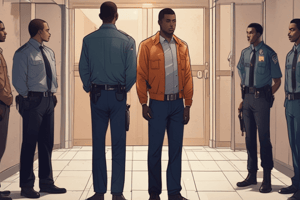Podcast
Questions and Answers
Which of the following best describes the purpose of judicial review?
Which of the following best describes the purpose of judicial review?
- To create new laws through court decisions
- To oversee the enforcement of laws by the executive
- To determine the legality of legislative actions (correct)
- To interpret laws and their meanings
What is the primary function of a legislature within the American government?
What is the primary function of a legislature within the American government?
- To enforce laws created by the executive
- To create laws and amend existing ones (correct)
- To adjudicate disputes within the legal system
- To run the electoral process and manage voting
Which concept argues that the components of the criminal justice system are in conflict?
Which concept argues that the components of the criminal justice system are in conflict?
- Judicial Review
- Plea Bargain
- Penal Code
- Nonsystem Argument (correct)
What is the composition of the United States Supreme Court?
What is the composition of the United States Supreme Court?
Which statement accurately describes the term 'Juvenile Justice'?
Which statement accurately describes the term 'Juvenile Justice'?
What does the term 'Unconstitutional' imply?
What does the term 'Unconstitutional' imply?
What is meant by a hierarchical organizational structure?
What is meant by a hierarchical organizational structure?
The term 'Judiciary' refers to the regulations governing criminal procedures.
The term 'Judiciary' refers to the regulations governing criminal procedures.
Judicial Review is the capability of the Supreme Court to assess the legality of executive actions.
Judicial Review is the capability of the Supreme Court to assess the legality of executive actions.
Legislatures have the ultimate authority to interpret the Constitution.
Legislatures have the ultimate authority to interpret the Constitution.
Which statement accurately reflects the evolution of juvenile justice in the United States?
Which statement accurately reflects the evolution of juvenile justice in the United States?
What concept highlights the state's role in addressing the needs of children within the juvenile justice system?
What concept highlights the state's role in addressing the needs of children within the juvenile justice system?
What is the significance of the Bill of Rights in relation to civil liberties?
What is the significance of the Bill of Rights in relation to civil liberties?
Which branch of government is primarily responsible for the enactment of statutes defining crimes?
Which branch of government is primarily responsible for the enactment of statutes defining crimes?
What role does the federal government primarily serve in the criminal justice system?
What role does the federal government primarily serve in the criminal justice system?
Which aspect of the criminal justice system is predominantly managed by state legislatures?
Which aspect of the criminal justice system is predominantly managed by state legislatures?
How are criminal laws organized for legal reference?
How are criminal laws organized for legal reference?
What role do trial courts play in the criminal justice system?
What role do trial courts play in the criminal justice system?
Which statement accurately reflects the nature of most criminal cases according to conventional wisdom?
Which statement accurately reflects the nature of most criminal cases according to conventional wisdom?
What is the principle of judicial review primarily concerned with?
What is the principle of judicial review primarily concerned with?
What role do governors have in the criminal justice system?
What role do governors have in the criminal justice system?
What does the concept of fairness in the criminal justice system emphasize?
What does the concept of fairness in the criminal justice system emphasize?
Which aspect of discretion is particularly significant within the highest levels of government in the criminal justice system?
Which aspect of discretion is particularly significant within the highest levels of government in the criminal justice system?
What does efficiency mean in the context of the criminal justice system?
What does efficiency mean in the context of the criminal justice system?
Which of the following describes the constitutional framework within the American criminal justice system?
Which of the following describes the constitutional framework within the American criminal justice system?
Flashcards are hidden until you start studying
Study Notes
Organizational Structure
- Hierarchical structure organizes elements based on rank and authority.
Legal Doctrines and Systems
- Infancy Defense refers to the common law principle that very young children cannot form a culpable mental state, exempting them from criminal prosecution.
- Judicial Review empowers the Supreme Court to assess the constitutionality of legislative actions.
- The Judiciary encompasses the collective court system of a country or state.
Criminal Justice Framework
- Juvenile Justice comprises components tailored to address criminal behavior by individuals not yet classified as adults.
- The Legislature, such as Congress, holds the authority to create laws under the Constitution.
- The Nonsystem Argument posits that the criminal justice system's elements conflict, suggesting the absence of a cohesive system.
Legal Definitions and Processes
- Penal Code consists of statutes detailing crimes and their associated penalties, also known as substantive criminal law or criminal code.
- A Plea Bargain is an agreement wherein a defendant pleads guilty to a lesser charge or receives a reduced sentence to avoid trial.
- Procedural Due Process mandates fair treatment within the criminal justice system, ensuring constitutional rights are upheld.
Government Structure
- The System is characterized by interrelated parts functioning collectively to achieve shared objectives.
- The Three Branches of Government include the executive, legislative, and judicial branches, as established by the Constitution.
Constitutional Context
- Unconstitutional denotes actions or laws that fail to align with either the U.S. Constitution or state constitutions.
- The United States Supreme Court, the nation's highest court, consists of eight associate justices and one chief justice.
Organizational Structure
- Hierarchical structure organizes elements based on rank and authority.
Legal Doctrines and Systems
- Infancy Defense refers to the common law principle that very young children cannot form a culpable mental state, exempting them from criminal prosecution.
- Judicial Review empowers the Supreme Court to assess the constitutionality of legislative actions.
- The Judiciary encompasses the collective court system of a country or state.
Criminal Justice Framework
- Juvenile Justice comprises components tailored to address criminal behavior by individuals not yet classified as adults.
- The Legislature, such as Congress, holds the authority to create laws under the Constitution.
- The Nonsystem Argument posits that the criminal justice system's elements conflict, suggesting the absence of a cohesive system.
Legal Definitions and Processes
- Penal Code consists of statutes detailing crimes and their associated penalties, also known as substantive criminal law or criminal code.
- A Plea Bargain is an agreement wherein a defendant pleads guilty to a lesser charge or receives a reduced sentence to avoid trial.
- Procedural Due Process mandates fair treatment within the criminal justice system, ensuring constitutional rights are upheld.
Government Structure
- The System is characterized by interrelated parts functioning collectively to achieve shared objectives.
- The Three Branches of Government include the executive, legislative, and judicial branches, as established by the Constitution.
Constitutional Context
- Unconstitutional denotes actions or laws that fail to align with either the U.S. Constitution or state constitutions.
- The United States Supreme Court, the nation's highest court, consists of eight associate justices and one chief justice.
Overview of the Criminal Justice System
- Each of the Three Branches of Government—Legislative, Judicial, and Executive—plays a critical role in the criminal justice system.
- Responsibilities are shared across federal, state, and local levels, with local government primarily handling law enforcement and jail operations.
- State governments focus on criminal laws and corrections, while the federal government mirrors these functions on a national level.
Role of the Legislature
- Legislatures, like Congress and state assemblies, enact statutes defining crimes and punishments.
- Criminal codes organize these statutes by subject, primarily originating from state legislatures in the U.S.
- Legislatures also provide essential funding for criminal justice agencies, which is necessary for their operation.
Role of the Judiciary
- The judiciary is divided into trial courts and appellate courts, forming a hierarchical system.
- Trial courts determine guilt and impose sentences; most criminal cases result in guilty pleas rather than jury trials.
- Appellate courts review cases from trial courts, focusing on complaints regarding treatment and the constitutionality of laws.
- Judicial review allows appellate courts to invalidate unconstitutional laws, with the Supreme Court being the highest authority influencing police conduct and criminal justice practices.
Role of the Executive
- The executive branch includes the President, governors, and mayors, who appoint key figures in the criminal justice system.
- Executives influence criminal justice agendas and public opinion, with discretion playing a significant role in decision-making processes.
- Discretion varies at different levels and affects the daily functions of law enforcement and judicial decisions.
Common Objectives in Criminal Justice
- Goals identified by the Bureau of Justice Statistics include efficiency (optimal use of resources), effectiveness (equity in justice actions), and fairness (ensuring equal treatment under the law).
- Fairness is rooted in the concept of due process, emphasized by the Supreme Court regarding procedural due process for defendants.
Constitutional Framework
- The U.S. has dual criminal justice systems: federal and state, each with law enforcement, judiciary, and correctional elements.
- Local law enforcement typically enforces state laws, while federal agents focus on federal law violations.
- Local and state governments bear the majority of criminal justice responsibilities in the U.S.
Nonsystem Argument
- Critics argue that the U.S. criminal justice system lacks cohesion, with police, courts, and corrections operating independently without a unified purpose, challenging the notion of it being a true system.
Rules Governing Criminal Justice
- The U.S. Constitution, particularly the Bill of Rights, embodies essential civil liberties and rules governing criminal justice activities.
- Federal statutes are organized in the U.S. Code, while states have their own criminal codes and procedural rules.
Discretion in Criminal Justice
- Discretion grants criminal justice agents the authority to make decisions based on professional judgment, addressing the variability of real-life situations.
- Police officers and prosecutors use discretionary powers in various decisions, from arrests to plea bargains.
Juvenile Justice
- Historically, children were treated like adults in the criminal justice system; however, perceptions shifted in the 19th century.
- The Juvenile Court movement, starting in Illinois in 1899, created a separate system focused on treatment and rehabilitation for youth offenders.
- The juvenile justice system emphasizes the state's responsibility to guide and correct children rather than punish them as adults.
Studying That Suits You
Use AI to generate personalized quizzes and flashcards to suit your learning preferences.




